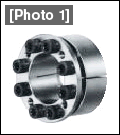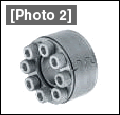HOME > Low Cost Automation Tutorial > #088 Motion Mechanism Design - 5 : Clamping Devices for Motor Shafts and Sprockets
Low Cost Automation Tutorial
#088 Motion Mechanism Design - 5 : Clamping Devices for Motor Shafts and Sprockets
Category : Drive mechanism design
September30, 2011
| Methods of fastening two coaxial rotating parts (shaft and hub pair: shaft and sprocket, gear, pulley, etc.) include: (1) keyed fastener, (2) screw fastener, and (3) friction locking methods. This section describes an easy-to-lock-and-unlock, reliable friction locking device, the standard Mecha-lock (FACE FA Standard Parts Catalog P993−996: [Photo 1]) |

|
(1) Principle of friction locking
The screws of a friction locking device tighten to apply radial force to the outside diameter surface of a shaft and the inside diameter surface of a hub to produce the frictional force that coaxially locks the shaft and the hub.
(2) Structure of Mecha-lock
The Mecha-lock selected for use in the work transfer conveyor is a tapered sleeved MLNP10. (See p. 996 of the catalog and Fig. 1.)
![[Fig. 1] Cross-sectional view of the tapered sleeved Mecha-lock [Fig. 1] Cross-sectional view of the tapered sleeved Mecha-lock](http://www.misumi-techcentral.com/tt/en/lca/images/092_02.gif)
| Tightening the locknuts produced the nominal force by the wedge effects from the outer ring and the inner ring. The frictional force produced by the nominal force locks the motor shaft and the sprocket. |

|
|
- Positioning technology
- Designing and processing
- Sensor Technology
- Automation elements technology
- Clean room technology
- Design hints
- Design tips
- Designing and Machining
- Drive mechanism design
- Hints on designing
- Linear Motion Components
- Locating Technology
- Manufacturing technology
- Motion mechanism design
- Pneumatic Drives
- Production Technology
- Technology Outlook
- General description
- Low-cost automation and materials
- Transfer LCA
- #333 Know-how on automation: Pressurized heating technology - 5: Multilayer pressurized heating process technique
- #332 Know-how on automation: Pressurized heating technology - 4: Points to remember when designing mechanism of pneumatic pressurization method
- #331 Know-how on automation: Pressurized heating technology - 3: Pneumatic pressurization method and pressure profile
- #330 Know-how on automation: Pressurized heating technology - 2: Pressurization method and pressure profile
- #329 Know-how on automation: Pressurized heating technology



